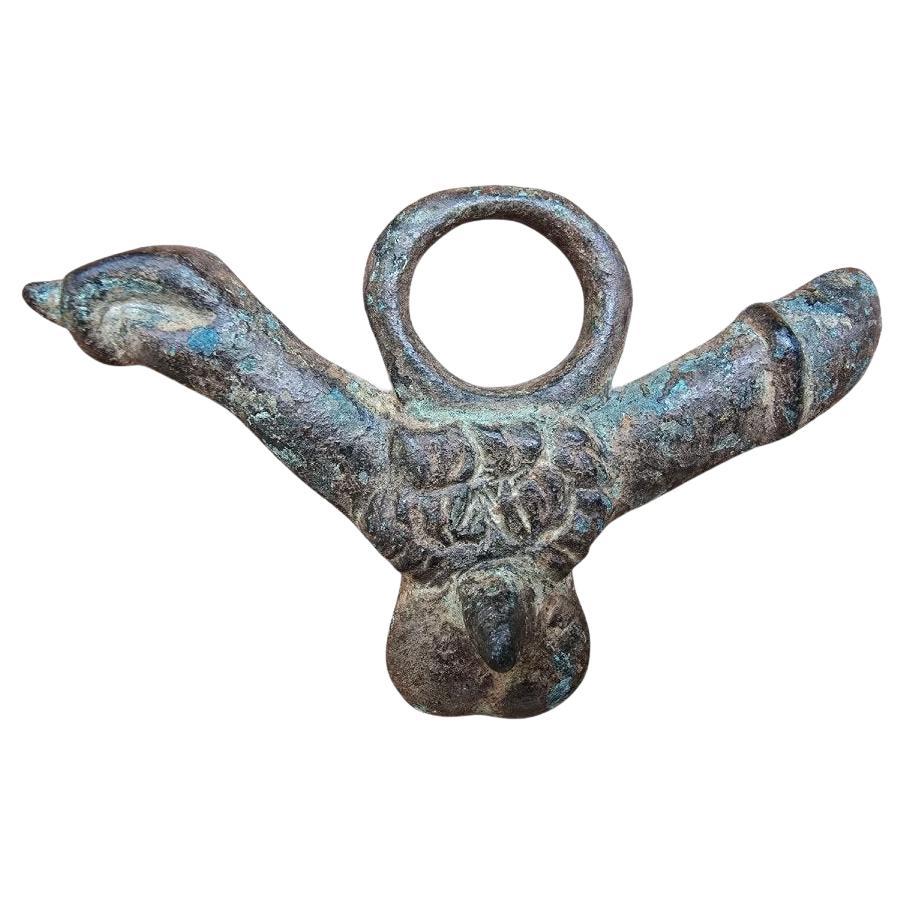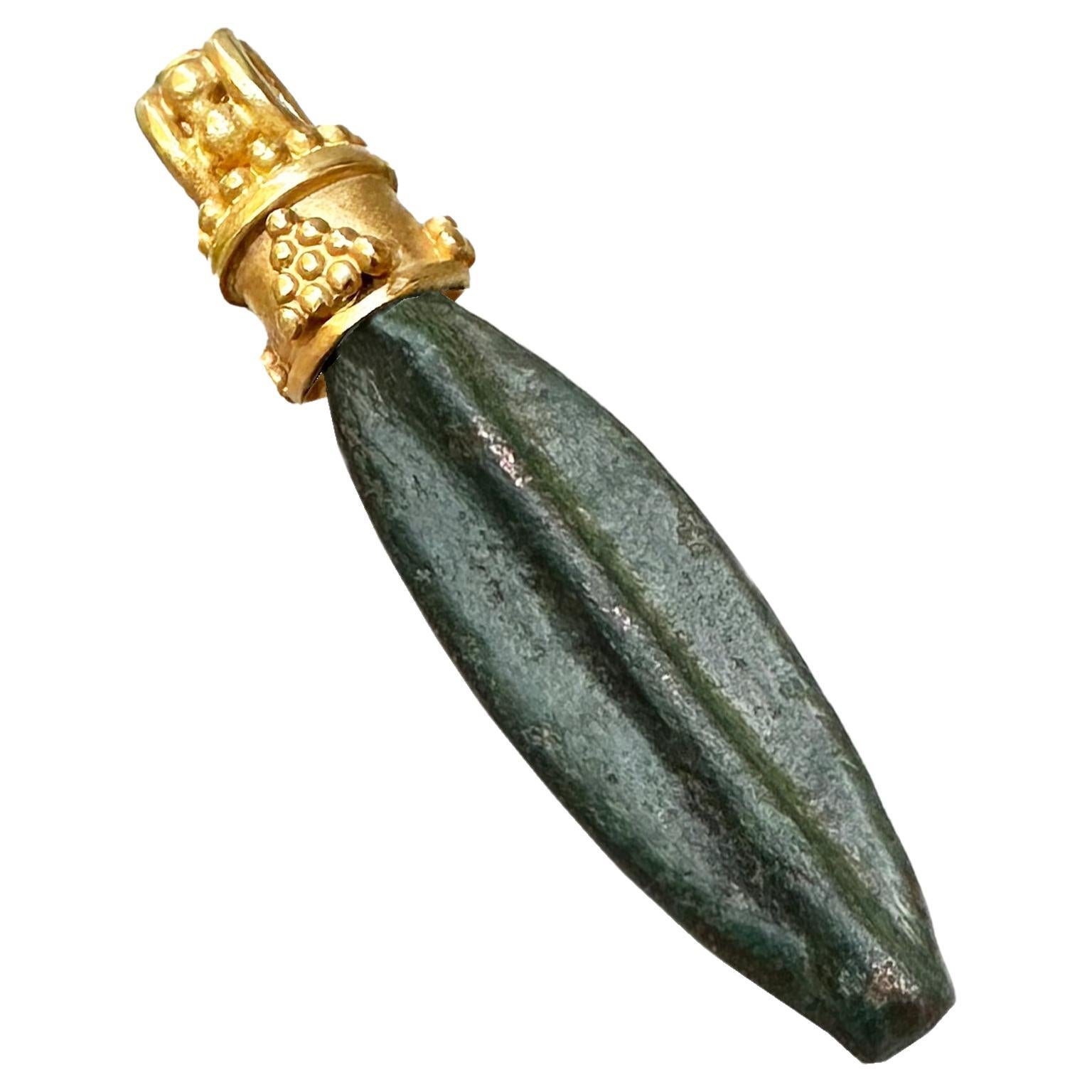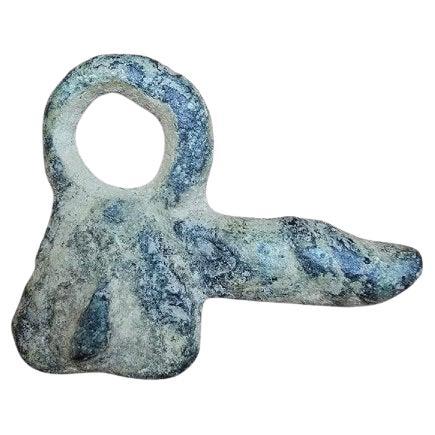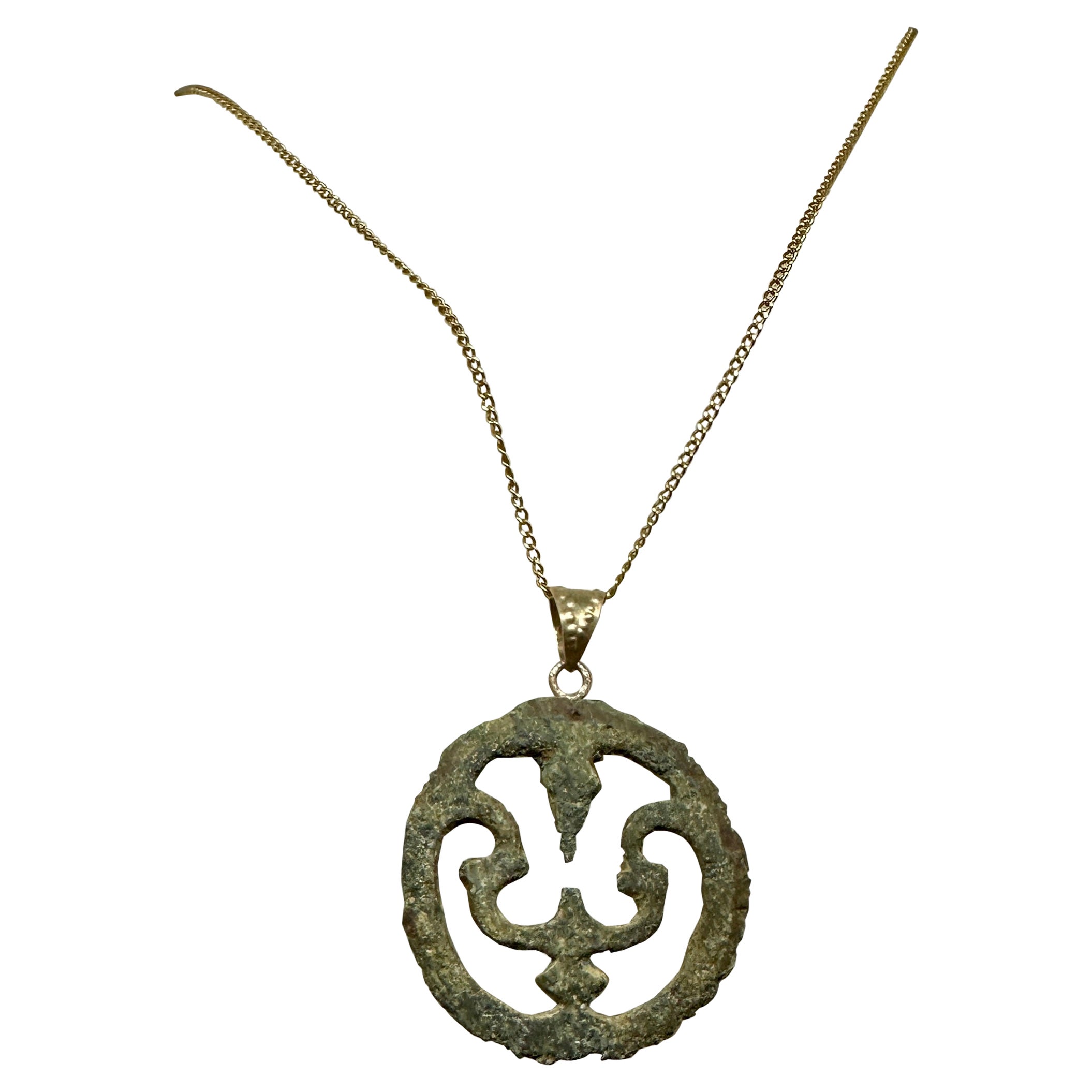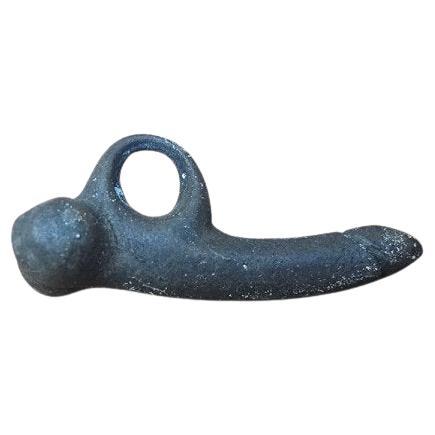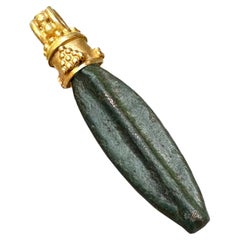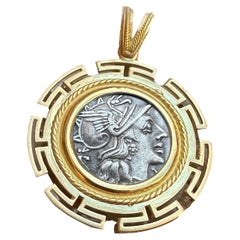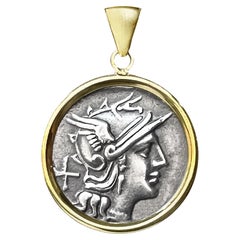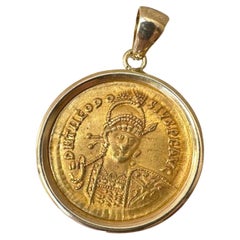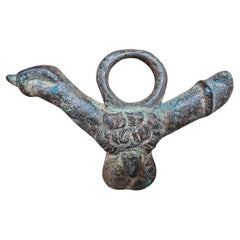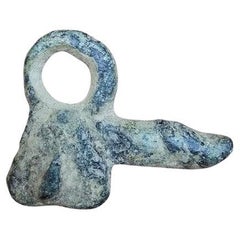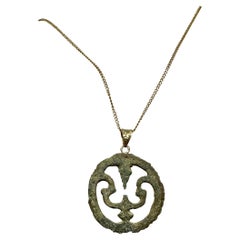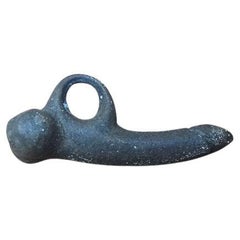Items Similar to Roman Bronze Phallus-Fascinus 1st-3rd Cent. AD 18 Kt Gold Pendant
Video Loading
Want more images or videos?
Request additional images or videos from the seller
1 of 8
Roman Bronze Phallus-Fascinus 1st-3rd Cent. AD 18 Kt Gold Pendant
$2,869.48
£2,124.28
€2,400
CA$3,970.64
A$4,377.54
CHF 2,290.19
MX$53,704.28
NOK 28,828.92
SEK 26,959.60
DKK 18,281.73
About the Item
In ancient Roman religion and magic, the fascinus or fascinum was the embodiment of the divine phallus. The word can refer to phallus effigies and amulets, and to the spells used to invoke his divine protection.Pliny calls it a medicus invidiae, a "doctor" or remedy for envy (invidia, a "looking upon") or the evil eye.
The English word "fascinate" ultimately derives from Latin fascinum and the related verb fascinare, "to use the power of the fascinus", that is, "to practice magic" and hence "to enchant, bewitch". Catullus uses the verb at the end of Carme 7, a hendecasyllabic poem .
Phallic charms, were ubiquitous in Roman culture, appearing as objects of jewellery such as pendants and finger rings, relief carvings, lamps, and wind chimes (tintinnabula). Fascinus was thought particularly to ward off evil from children, mainly boys, and from conquering generals. The protective function of the phallus is usually related to the virile and regenerative powers of an erect phallus.
Varro notes the custom of hanging a phallic charm on a baby's neck, and examples have been found of phallus-bearing rings too small to be worn except by children. A 2017 experimental archaeology project suggested that some types of phallic pendant were designed to remain pointing outwards, in the direction of travel of the wearer, in order to face towards any potential danger or bad luck and nullify it before it could affect the wearer.
- Creator:SERRA
- Metal:
- Dimensions:Length: 1.38 in (35 mm)
- Style:
- Place of Origin:
- Period:
- Date of Manufacture:2021
- Condition:
- Seller Location:Roma, IT
- Reference Number:1stDibs: LU1922213810252
About the Seller
5.0
Gold Seller
Premium sellers maintaining a 4.3+ rating and 24-hour response times
1stDibs seller since 2020
48 sales on 1stDibs
Typical response time: 7 hours
- ShippingRetrieving quote...Shipping from: Roma, Italy
- Return Policy
Authenticity Guarantee
In the unlikely event there’s an issue with an item’s authenticity, contact us within 1 year for a full refund. DetailsMoney-Back Guarantee
If your item is not as described, is damaged in transit, or does not arrive, contact us within 7 days for a full refund. Details24-Hour Cancellation
You have a 24-hour grace period in which to reconsider your purchase, with no questions asked.Vetted Professional Sellers
Our world-class sellers must adhere to strict standards for service and quality, maintaining the integrity of our listings.Price-Match Guarantee
If you find that a seller listed the same item for a lower price elsewhere, we’ll match it.Trusted Global Delivery
Our best-in-class carrier network provides specialized shipping options worldwide, including custom delivery.More From This Seller
View AllRoman arrowhead 2-6th century BC mounted in 18 kt gold, olive-green patina
Located in Roma, IT
This small bronze arrowhead, exhibiting an olive-green patina, resembles examples from the Villa Julia Collection. It is mounted in 18-karat gold, showcasing an exclusive design by t...
Category
Antique 15th Century and Earlier Classical Roman Pendant Necklaces
Materials
18k Gold, Bronze
Genuine Ancient Roman Coin 148 BC 18Kt Gold Pendant Depicting Goddess Rome
Located in Roma, IT
An authentic Roman silver coin from 148 BC, depicting the Goddess Roma, has been set in this 18 kt gold pendant. On the reverse of the coin, we see the Dioscuri.
In ancient Roman re...
Category
Antique 15th Century and Earlier Italian Classical Roman Pendant Necklaces
Materials
18k Gold
Genuine Ancient Roman Coin 150 BC 18Kt Gold Pendant Depicting Goddess Rome
Located in Roma, IT
Discover a remarkable 18kt gold pendant featuring an original Roman silver coin dating back to 150 BC. This exquisite piece showcases a captivating depiction of the revered Goddes...
Category
Antique 15th Century and Earlier Italian Classical Roman Pendant Necklaces
Materials
18k Gold
Gold Byzantine Coin 18KT gold Pendant Depicting the Emperor Theodosius II
Located in Roma, IT
This magnificent 18 Kt gold pendant features an authentic Roman coin (solidus) in 24 Kt gold, dating back to the 5th century A.D., depicting Emperor Theodosius II on one side and the...
Category
2010s Italian Classical Roman Pendant Necklaces
Materials
18k Gold, 24k Gold, Gold
BOW BEETWEN TWO SNAKES Genuine Ancient Greek coin 190-133 BC Pendant
Located in Roma, IT
Discover a genuine Roman coin pendant from 82 BC, featuring a bow with arrow between two coiled serpents on the front and a mystic cista on the reverse. This remarkable piece was min...
Category
Antique 15th Century and Earlier Italian Classical Greek Pendant Necklaces
Materials
Silver
VENETIAN DOGE Gold Coin 18Kt Gold Pendant
Located in Roma, IT
This exquisite Venetian Doge Genuine Gold Coin Pendant is a stunning piece of history and craftsmanship. Dating back to the 17th century AD, this authentic 18kt gold pendant features...
Category
Antique 15th Century and Earlier Italian Renaissance Pendant Necklaces
Materials
18k Gold
You May Also Like
Rare Roman Bronze Phallic Amulet, 1st–2nd Century AD
Located in Madrid, ES
An exceptional example of ancient Roman craftsmanship, this rare bronze amulet dates to the height of the Roman Empire, circa 1st–2nd century AD. Cast in solid bronze with a striking...
Category
Antique 15th Century and Earlier European Classical Roman Collectible Je...
Materials
Bronze
Roman Bronze Phallic Amulet, 1st–2nd Century AD
Located in Madrid, ES
Authentic Roman bronze amulet, dating between the 1st and 2nd centuries AD, at the height of the Roman Empire. This piece has a beautiful natural patina that attests to its age and a...
Category
Antique 15th Century and Earlier European Classical Roman Collectible Je...
Materials
Bronze
Ancient Roman Bronze Buckle Pendant Necklace 14K Gold 1st-2nd C. AD Guarantee
Located in New York, NY
Unveil the elegance of antiquity with this Ancient Roman Bronze Buckle Pendant, dating from the 1st to 2nd century AD (100-200 AD) with a 14 Karat Gold hand hammered bale. The fine...
Category
Antique 15th Century and Earlier Italian Classical Roman Pendant Necklaces
Materials
Gold, 14k Gold, Yellow Gold, Bronze
Roman Bronze Phallic Amulet, 1st–2nd Century AD
Located in Madrid, ES
A finely cast Roman bronze phallic amulet from the 1st to 2nd century AD, this diminutive yet powerful artifact embodies the deeply rooted Roman tradition of apotropaic symbolism. Kn...
Category
Antique 15th Century and Earlier European Classical Roman Collectible Je...
Materials
Bronze
Roman Duckhead Fragment Pendant w 21K
Located in Atlanta, GA
A charming bronze duck head from the Ancient Roman Empire fashioned into a pendant trimmed with 21K gold accents and bale. There is a marvelous patina that demonstrates the fragment'...
Category
Antique 15th Century and Earlier Unknown Classical Roman Pendant Necklaces
Materials
22k Gold, Bronze
Roman Bronze Amulet, 1st–2nd Century AD
Located in Madrid, ES
Authentic Roman bronze amulet, dating between the 1st and 2nd centuries AD, at the height of the Roman Empire. This piece has a beautiful natural patina that attests to its age and a...
Category
Antique 15th Century and Earlier European Classical Roman Collectible Je...
Materials
Bronze
$358 / item
More Ways To Browse
Phallus Ring
Roman Phallus
Ancient Greek Coin Necklace
Antique Gold Garnet Necklaces
Lock Pendant
Vintage 18k Zodiac
Vintage French Zodiac
Antique Gold Cameo Necklaces
Antique Gold Curb Chain
Green Necklace Art Deco
Jade Fei Cui
Ruby Cross Necklaces
Trillion Diamond Pendant
Van Cleef Mother Of Pearl
14k Medallion
1980s Pearl Necklace
Dancing Pendant
Deco Tassel
